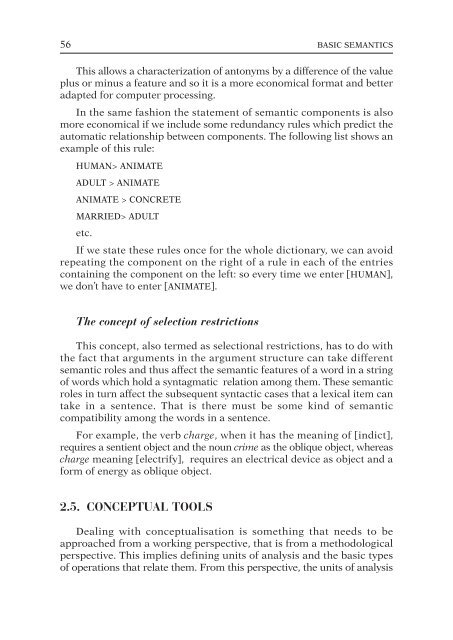Semantics
You also want an ePaper? Increase the reach of your titles
YUMPU automatically turns print PDFs into web optimized ePapers that Google loves.
56 BASIC SEMANTICS<br />
This allows a characterization of antonyms by a difference of the value<br />
plus or minus a feature and so it is a more economical format and better<br />
adapted for computer processing.<br />
In the same fashion the statement of semantic components is also<br />
more economical if we include some redundancy rules which predict the<br />
automatic relationship between components. The following list shows an<br />
example of this rule:<br />
HUMAN> ANIMATE<br />
ADULT > ANIMATE<br />
ANIMATE > CONCRETE<br />
MARRIED> ADULT<br />
etc.<br />
If we state these rules once for the whole dictionary, we can avoid<br />
repeating the component on the right of a rule in each of the entries<br />
containing the component on the left: so every time we enter [HUMAN],<br />
we don’t have to enter [ANIMATE].<br />
The concept of selection restrictions<br />
This concept, also termed as selectional restrictions, has to do with<br />
the fact that arguments in the argument structure can take different<br />
semantic roles and thus affect the semantic features of a word in a string<br />
of words which hold a syntagmatic relation among them. These semantic<br />
roles in turn affect the subsequent syntactic cases that a lexical item can<br />
take in a sentence. That is there must be some kind of semantic<br />
compatibility among the words in a sentence.<br />
For example, the verb charge, when it has the meaning of [indict],<br />
requires a sentient object and the noun crime as the oblique object, whereas<br />
charge meaning [electrify], requires an electrical device as object and a<br />
form of energy as oblique object.<br />
2.5. CONCEPTUAL TOOLS<br />
Dealing with conceptualisation is something that needs to be<br />
approached from a working perspective, that is from a methodological<br />
perspective. This implies defining units of analysis and the basic types<br />
of operations that relate them. From this perspective, the units of analysis



